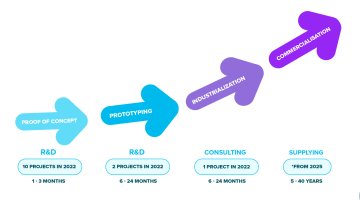RVmagnetics: A Successful Use Case Identification
As our line of work is manufacturing unique measurement solutions based on MicroWire sensor sensing technology, we are no strangers to close cooperation with strategic investors. We are essentially a startup that delivers R&D services (as well as supplies ready solutions), to the aforementioned strategic investors. We have gone above and beyond and identified navigation through the journey of an Idea, becoming a final Solution.
A client, a partner or an investor want to get behind our solutions as they intend to:
- Solve a measurement challenge that other sensors couldn’t solve for them (due to variety features of our MicroWires such as size, contactless detection, low power consumption, multiple measurements with one interface, resistance to harsh environmental conditions, etc.
- Upgrade existing features of an application, production process, materials and parts by accessing more accurate physical data, with little to know design changes
Requirements from each stakeholder usually differ due to the application type, necessary physical quantities to measure, expected accuracies and resolutions, material types, the physical space where the measurements are necessary, overall environment, etc.
Our R&D team considers it a priority to be peculiar in definition stage of the technical solution, in cooperation with the partner company’s technical arms, add to that the need for the solution to have an eventual, long-term value value of gaining control over their process or product by having a reliable data to act on it. In this context, one of the most important tasks we have in our hands is the proper ideation process, with usually limited information.
How Do We Address This Technical Uncertainty?
A. Choosing the right partner
this usually means the partner, investor or client, that has previous experience in R&D, knows the time and resource consumption specifics, and the potential value in R&D investments. We are fortunate enough to realise the opportunity costs we have both at our and potential partner’s end, thus we carefully examine the cooperation possibilities with a potential strategic investor, before we can confirm the work from our side.
B. Get to talk with the right person in the company
As our work carries technical specifications (physics, chemistry, IT, El. engineering, etc.), we surely need the technical conversations to be carried out with the relevant colleagues from the cooperation side, however, it is no less important to keep the finger on the pulse from the big picture point of view as well – before each technical definition is completely confirmed, both RVmagnetics and the strategic investor need to have the validity of the potential use case confirmed. In conclusion, from the technical end we usually communicate with the technical decision makers (such as CTO, Solution Architect, Director of Engineering, etc.), and from the business definition perspective we communicate with final strategic decision makers (CPO, CEO, Investment Analyst, IP specialists, Innovation Lead, etc.)
C. Create Confidence in the possibility of the final Application
Here, there are also two points to address like there is above –
- Confidence in the technical solution – the stakeholders will need the approval form the technical decision makers that the application is possible to achieve. We usually do this with a developing a Proof of Concept which addresses the most risky assumptions about the application, while not spending too much time or money on the development efforts
- Return on Investment – based on the initial Proof of Concept (practically a research part of our R&D activities) it is now easier to estimate the necessary investments in development of the Prototype, as well as potential price of the final application (i.e. the unit price)
We value this stage of cooperation vastly, as this is where common trust is created. Our partner can validate the readiness of our technology for their application, and RVmagnetics can see the commitment from the lead for becoming a longer-term partner or a cooperating entity who is willing to invest in the basic validation as Proof of Concept and beyond.
D. Development, Testing, Constant RoI validation
Experience shows that when the above steps are sufficiently overcome, the development goes smoothly as well. We go on with the predetermined plans, produce the MicroWIre, sensing system, electronics, software, we calibrate the system and all this with often progress checks (i.e. bi-weekly).
When performing an R&D, we naturally face something new, thus the learnings from testing may need to alter the next steps of the predetermined roadmap – we naturally communicate the change, and confirm the relevant eventual RoI, to be certain it still valid to work towards the end-goal of the project
- One of the main testing points of the development is the production of a Minimum Viable Product (MVP) – it demonstrates the feasibility of the mass manufacturing of the product, as well as generates important feedback from the final beneficiaries – in this context an MVP in the Technical definition is in the TRL4
- Once the MVP is confirmed, we step into mass production, based on the agreed terms, periods and other conditions. Here is when RVmagnetics transforms to a supplier from an R&D service provider. As the MicroWire technology is uniquely ours – we do also provide the necessary consultation along the supplied MicroWire.

To navigate the above processes we use the Technology Readiness Levels (TRL): Technology Readiness Level is a measure that describes the maturity of a technology or innovation. TRL is typically used in R&D applications to evaluate the readiness of a technology for commercialization or implementation.
TRL ranges from 1 to 9, with 1 being the lowest level of maturity and 9 being the highest. Here's a quick and easy description of each level:
this TRL scale is the representation of the High-Level Expert Group on Key Enabling Technologies (HLG-KET) of the TRL built by EU
- 1. Basic principles observed and reported: based on research, there is an idea
- 2. Technology concept formulated: identifying the concept of the solution
- 3. Proof of concept: addressing the few features, or most risky assumptions about the final idea, to prove the validity of concept
- 4. Technology validated in the lab: the technology is validated in a laboratory environment, the difference from point 3 here, is that this stage is not experimental
- 5. Technology validated in the relevant environment: a relevant environment here is not the operational one, but an environment where the conditions are similar to that of the operational environment, this corresponds to the definition of an MVP as well.
- 6. Technology demonstrated in relevant environment: exponentially developed version of the Proof of Concept, this stage demonstrates not only the feasibility but the actual technology in operation
- 7. System prototype demonstration in operational environment: a prototype of the technology is created, and demonstrated
- 8. System complete and qualified: the system can be used in an operational environment
- 9. Actual system proven in operational environment: proven, demonstrated and validated use of the technology in an operational environment

These help us translate our technical operational conditions into internationally known standards of a technology from the Idea state all the way to the “Actual System Proven in Operational Environment” (TRL9).
This cycle is what an investor is looking for from an R&D startup in our case, to generalize it and confirm for startups and investors from other sectors – we find the possibility to bring back added value, possibly in a long term, on a relatively low investment and in a form of close, trusted cooperation rather then employment or acquisition – to be the main motivation of an investor to invest strategically.
Conclusion
In a general state as a company we are moving to the commercialized, mass manufacturing stages with a few of our long-term partners, and while choosing each use case to pursue we have this technical model in mind. Sure, sometimes the model differs as not all the unique measurement systems need to be mass manufactured for a company, sometimes one or a few systems are enough to solve a challenge for a lifetime of a new, better application, however even then, the R&D, Consulting, and Supplying arms of RVmagnetics team are oriented firstly through certain TRLs.

To conclude all of the above, however, we are convinced that our expertise, thus our team is what is the most attractive for a potential partner, client, or investor, and the feasibility of the solution, comes only after. In our modern world, new and exciting tech can come up from a variety of hidden corners, and it is exciting to hang on to those, however, if the providers of the solution will not have the necessary qualifications – it is a road to nowhere. In other words, alongside the uniqueness and the great added value, you want to bet the jockey, not the horse.
